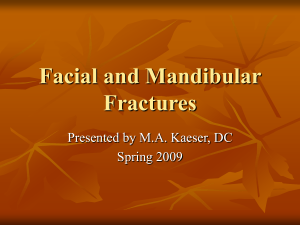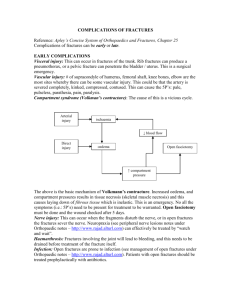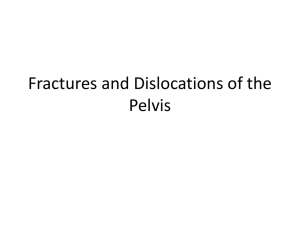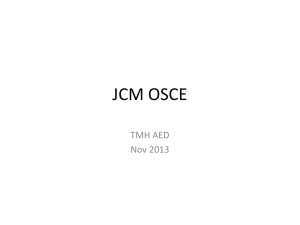Mandibular Fractures
advertisement
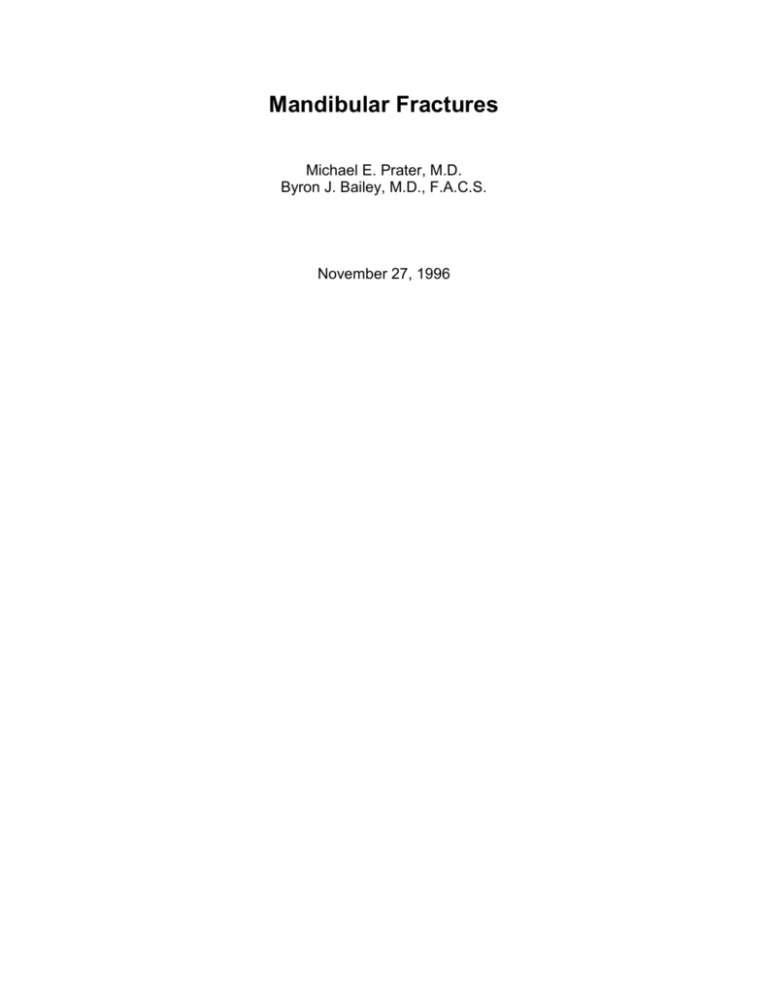
Mandibular Fractures Michael E. Prater, M.D. Byron J. Bailey, M.D., F.A.C.S. November 27, 1996 Table of Contents I. History A. Ancient Egypt B. Ancient Greece C. “Modern” Europe D. America II. Anatomy A. Bony landmarks B. Occlusion C. Fracture Sites D. Innervation E. Arterial supply F. Musculature G. Factors in fracture displacement III. Diagnosis of Mandibular Fractures A. History B. Physical Exam C. Radiographic exam IV. General Principles of Therapy of Mandibular Fractures A. General physical status B. Dental injuries C. “Classical” indications for closed reduction D. “Classical” indications for open reduction E. Contraindications to MMF V. Treatment Techniques A. Closed reduction of the dentulous patient B. Closed reduction of the partially dentulous patient C. Closed reduction of the edentulous patient D. Open reduction and fixation-osteosynthesis E. Open reduction and rigid fixation VI. Complications of Mandibular Fractures A. Socioeconomic conditions B. Delayed healing and malunion C. Paresthesias/anesthesias D. Infection VII. Controversies A. Angle fractures B. Condylar fractures Mandibular Fractures I. History A. Ancient Egypt: The Edwin Smith Treatise 1. Written approximately 3000 B.C. in hieroglyphics, but “carpetbagged” by American Edwin Smith in approximately 1862, who bought it off an Egyptian peasant for mere trinkets. 2. “An ailment to be treated.” “An ailment with which to contend” “An ailment not to be treated.” (Death usually followed) 3. “If thou examinist a man having a fracture in his mandible, thou shouldst place thy hand upon it... and find that fracture crepitating under thy fingers, thou shouldst say concerning him: One having a fracture in his mandible, over which a wound has been inflicted, thou will a fever gain from it. An ailment not to be treated.” Cause of death was assumed to be sepsis. B. Ancient Greece- Hippocrates 1. Written in 460 B.C. 2. The first description of closed reduction with MMF! 3. “Displaced but incomplete fractures of the mandible where continuity of the bone is preserved should be reduced by pressing the lingual surface with the fingers while counterpressure is applied from the outside. Following the reduction, teeth adjacent to the fracture are fastened to one another using gold wire.” C. “Modern” Europe 1. The first European medical school, in Salerno, Italy, was established in 1180 AD. 2. Religion dominated medical thinking. “Pure” science was generally discouraged, thus the teachings of Hippocrates, himself a son of a physician-priest, was considered heresy. 3. “(for mandibular fractures)...take olibaisum, mastic, colophene, glue and dragon blood; all this must be mixed with liquified resin until it becomes ointment, which is placed over (the fracture)...” D. America - Thomas Gunning 1. A dentist during the civil war, during which time the therapy of mandibular fractures was greatly advanced 2. Designed the “Gunning splint” in 1984 for William Seward, the Secretary of State to Abraham Lincoln, who suffered bilateral body fractures after falling out of a carriage. The splint was a single piece of vulcanite with a space for eating. Screws were used to stabilize the splint to the hard palate and the mandible. 3. Gunning declared Mr. Seward cured after several months of therapy. His assessment and methods were highly controversial, however, and most considered his treatment unsatisfactory. E. America - “Mr. Thomas” 1. Apparently a ship’s carpenter who fancied himself a scientist. 2. Pioneered open reduction with internal fixation in 1869 after a friend was struck by a piece of timber aboard ship. 3. He writes: “There was great mobility of the fractured part. My assistant kept him steady with a piece of wood directed across his face whilst I drilled a hole through the jaw. A strong silver wire was passed through ... and drawn tight, making the fracture firm. The site was tightened every four days. In four weeks it was sufficiently secure to allow the wire to be removed and the jaw used.” II. Anatomy A. Bony landmarks of the mandible 1. Condylar process 2. Coronoid process 3. Ramus 4. Angle 5. Oblique line 6. 7. 8. 9. Body Mental foramen Symphysis/parasymphysis Mental protuberance B. Occlusion - The Angle Classification 1. Based on the relationship of the mandibular and maxillary first molars a. Class I: normal occlusion b. Class II: mandibular first molar more anterior. An “underbite” c. Class III: mandibular first molar more posterior. An “overbite” C. Common Sites of Fracture 1. Condyle 36% 2. Body 21% 3. Angle 20% 4. Parasymphysis 14% 5. Coronoid, ramus, alveolus, symphysis all less than 3% each 6. Weak areas include the 3rd molar (particularly when impacted) and the canine fossa D. Innervation 1. Mandibular n. through the foramen ovale 2. Inferior alveolar n. through the mandibular foramen 3. Inferior dental plexus 4. Mental n. through the mental foramen E. Arterial supply 1. Internal maxillary artery from the external carotid artery 2. Inferior alveolar artery through the mandibular foramen 3. Mental artery through the mental foramen F. Musculature 1. Elevators of the jaw a. Masseter. Arises from the zygoma and inserts into the angle and the ramus b. Temporalis. Arises from the infratemporal fossa and inserts on the coronoid process and ramus c. Medial pterygoid. Arises from the medial pterygoid plate and pyramidal process of the palatine bone and inserts into the inner table fo the lower mandible 2. Depressors of the jaw a. Lateral pterygoid. Arises from the lateral pterygoid plate and inserts into the condylar neck and the temporalmandibular joint capsule b. Mylohyoid. Arises from the mylohyoid line and inserts into the body of the hyoid c. Digastric. Arises at the mastoid notch and inserts into the digastric fossa d. Geniohyoid. Arises from the inferior genial tubercle and inserts intto the anterior hyoid bone G. Anatomic Factors in Fracture Displacement 1. Favorable fractures are those fractures where the muscles tend to draw the fragments towards each other a. Ramus fractures are almost always favorable secondary to the elevating forces of the “jaw elevators” 2. Unfavorable fractures are those fractures where the musculature tends to draw the fragments apart a. Most angle fractures are horizontally unfavorable secondary to the “jaw elevators” b. Vertically unfavorable fractures of the symphysis and parasymphysis tend to collapse inward in a scissor-like manner secondary to the “jaw depressors”, particularly the mylohyoid m. III. Diagnosis of Mandibular Fractures A. History 1. Pre-existing pathology: a. bone disease b. neoplasia c. arthritis d. collagen vascular diseases e. nutrition and metabolic disorders, including alcohol abuse f. endocrine disorders g. temporomandibular joint disorders. These patients are at risk for ankylosis! 2. The type and direction of the force a. MVA’s tend to have multiple, compound and comminuted fractues b. A fist is often a single, non-displaced fracture c. An anterior blow to the chin often leads to bilateral condylar fractures d. an angledf blow to the parasymphysis often leads to contralateral condylar and or angle fractures e. Clenched teeth lead to alveolar process fractures B. Physical Exam 1. Change in occlusion a. Any change is occlusion is highly diagnostic of a mandible fracture b. Posterior premature dental contact or an anterior open bite is suggestive of bilateral condylar or angle fractures c. Posterior open bite is common with anterior alveolar process or parasymphyseal fractures d. Unilateral open bite is suggestive of an ipsilateral angle and parasymphseal fracture e. Retrognathic occlusion is seen with condylar or angle fractures f. Prognathic occlusion is seen with effusion of the TMJ 2. Anesthesia of the lower lip a. “pathognomonic” of a fracture distal to the mandibular foramen b. The converse is not true: all fractures distal to the mandibular foramen do not cause paresthesias 3. Abnormal mandibular movement a. Inability to open the mandible suggests impingement of the coronoid process on the zygomatic arch b. Inability to close the mandible suggests a fracture of the alveolar process, angle, ramus of symphysis, all of which lead to premature posterior dental contact c. Trismus leading to an inability to open the mouth more than 35 mm is highly suggestive of a mandibular fracture. The lower level of normal is 40 mm 4. Lacerations, Hematomas and Ecchymosis a. Lacerations: The direction and type or fractures can often be visualized through facial lacerations. If a mandibular fracture is present with a facial laceration, the laceration should not be closed until it is certain the laceration cannot be used to access the fracture. b. Ecchymosis of the floor of mouth is a diagnostic sign of a body or symphyseal fracture 5. Loose Teeth a. Multiple fractured teeth that are firm indicates a clenched jaw during the trauma. Think alveolar fracture 6. Palpation a. The mandible should be palapted with both hands, with the thumb on the teeth and the fingers on the lower border of the mandible. Slowly and carefully place pressure, noting the characteristic crepitation of a fracture C. Radiographic Exam 1. Panorex a. Advantages: shows the entire mandible b. Disadvantages: requires the patient to be upright. This is difficult in traumatized patient. Poor detail in the TMJ. Poor visualization of medial condylar displacement and alveolar process fractures. 2. AP - ramus and condyle 3. Submental - symphysis 4. CT: good for condylar fractures difficult to visualize by the panorex IV. General Principles in the Treatment of Mandibular Fractures A. The patient’s general physical status should be thoroughly and carefully evaluated prior to any consideration of mandibular fracture treatments. Mandibular fractures are not emergencies 1. 40% of all mandible fractures are associated with other significant injury of which approxiately 10% are lethal 2. Cerebral contusion is a common associated injury 3. As with all trauma, ABC’s! B. Diagnosis and therapy of mandibular fractures should be in a controlled fashion. Remeber, they are not emergencies. C. Dental injuries should be evaluated and treated concurrently 1. Re-establishment of occlusion is the primary goal. Good occlusion requires healthy, properly positioned teeth. 2. Fractured teeth can become infected and jeopardize bony union; however, an intact tooth in the line of a fracture can often be protected by antibiotics. Extraction is therefore a clinical decision. 3. A second molar in a posterior fracture should be maintained if at all possible to prevent superior displacement of bony fragments while in MMF 4. Mandibular cuspids are the cornerstone of proper occlusion. They should be maintained whenever possible 5. Remember: occlusion takes precedence over impressive radiographic gains 6. Prophylactic antibiotics are used for all compound fractures. All fractures in the line of teeth should be considered open D. With multiple facial fractures, mandibular fractures should be treated first to re-establish correct facial dimensions. 1. “inside out, from bottom to top” E. Classical Indication for Closed Reduction 1. Grossly comminuted fractures. These fractures will heal if the periosteum is intact. 2. Fractures with significant loss of soft tissue a. Tissue coverage is established by rotational flaps, free flaps, or if small enough, granulation tissue 3. Edentulous mandibles a. Closed reduction with mandibular prosthesis - a Gunning splint - with circum-mandibular and circumzygomatic wires is preferred 4. Fractures in children a. open reduction can lead to damage of developing teeth b. if grossly comminuted segments require open reduction with internal fixation, fine wires should be placed at the most inferior portion of the mandible c. closed reduction is performed with acrylic splints and circum-mandibular and circumzygomatic wires when possible 5. Condylar fractures a. Early jaw mobilization is required to avoid ankylosis of the TMJ. In children the mobilization should be performed every week, and in adults every two weeks. F. Classical Indications for Open Reduction 1. Displaced unfavorable fractures through the angle 2. Displaced unfavorable fractures of the body or parasymphysis a. when treated with closed reduction, these fractures tend to open at the inferior border, leading to malocclusion 3. Multiple fractures of facial bones a. the mandible is fixed first, providing a stable and accurate base for restoration 4. Midface fractures with displaced and bilateral condylar fractures a. One of the condyles should be opened to provide an accurate vertical dimension of the face 5. Malunion - perform osteotomies G. Contraindications to MMF 1. Seizure disorders, psychiatric disorders, compromised pulmonary function V. Treatment Techniques of Mandibular Fractures A. Closed Reduction of the Dentulous Patient 1. Erich Arch Bars a. can lead to periodontal inflammation b. avoid fixating incisors, as these can be orthodontically moved by the wires B. Closed Reduction of the Partially Edentulous Mandible 1. Pre-existing partial dentures can be wired to either jaw using circum-mandibular or circumzygomatic wires 2. If no partials exist, can make acrylic partials and incorporate with arch bar wire C. Closed Reduction of the Edentulous Patient 1. Dentures can be wired to jaw using cirum-mandibular or circumzygomatic wires 2. Screws can be used to fixate the dentures into the palate and mandible 3. If no dentures available, acrylic plates are made (Gunning Splints) with an arch bar processed into the plate 4. In fractures of the mandible and maxilla, circumzygomatic wires should be attached to circum-mandibular wires to prevent telescoping of the maxilla D. Open Reductiona and Fixation Using Wire Osteosynthesis 1. Simpler to place than rigid fixation 2. Still requires MMF 3. Useful in angle, parasymphyseal fractures E. Open Reduction and Rigid Fixation with Compression Plates and Lag Screws 1. Plates are made of stainless steel, cobalt, chromium alloy or titanium 2. Eccentrically placed holes and screws placed at an angle “compress” the bone 3. MMF generally not required VI. Complications of Mandibular Fractures A. Socioeconomic condition greatly affects outcome B. Infection 1. James, et. al., in a largely prospective study of 422 fractures found an infection rate of 7%, of which 50% were associated with fractured or carious teeth. Of the 177 fractures requiring ORIF, 12% became infected. Common pathogens were staph, strep and bacteroides. Recommendations include extraction of teeth which are significantly mobile, have root exposure, or interfere with reduction. Also, use prophylactic antibiotics. C. Delayed healing and malunion. 1. Most common cause is infection. See B. 2. Second most common cause is non-compliance. See A. 3. Inadequate reduction, metabolic and nutritional deficiency can play a role. 4. James’ study showed delayed union in 3% and nonunion in 1% D. Nerve paresthesias (inferior alveolar n.) occur in approximately 2% VII. Controversies with Fractures of the Mandibular Angle A. An 8 year prospective study at Parkland Hospital which ended in 1994 compared various methods and their complications Type Nonrigid AO Recon Plate DCP (x2) Non compression plate Number 99 52 30(65) 81 % Complication 17 8 13 (32) 3 References Bailey, Byron J., Head and Neck Surgery-Otolaryngology, J.B. Lippincott, 1993, 961-973. Ellis, E., “Therapy Methodsfor Fractures of the Mandibular Angle,” Journal of Craniomaxillofacial Trauma, 1996, 28-34. Fonseca, RJ, et. al., Oral and Maxillofacial Trauma, W.B. Saunders, 1991, 359405. Hall, Mathew B., “Condylar Fractures: Surgical Management,” Journal of Oral and Maxillofacial Surgery, 1994, 1189-92. Hippocrates: Oiuvres Completes. English by E.T. Withnington. Cambridge, 1928. James, RB, “Prospective Study of Mandibular Fractures,” Journal of Oral Surgery, 1981, 275. Marciani, R.D., et. al., “Therapy of Mandibular Angle Fractures,” Journal of Oral and Maxillofacial Surgery, 1994, 752-756. Smith, E., Papyrus. Translated by Breasted, 1930. Walker, Robert, “Condylar Fractures: Nonsurgical Management,” Journal of Oral and Maxillofacial Surgery, 1994, 1185-1188.
